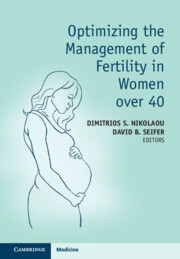Book contents
- Optimizing the Management of Fertility in Women over 40
- Optimizing the Management of Fertility in Women over 40
- Copyright page
- Dedication
- Contents
- Contributors
- Introduction
- Section 1 Demographic Trends
- Section 2 Biological Basis of Female Reproductive Aging: What Happens to the Ovaries and the Uterus as they Age?
- Section 3 Lifestyle, Environment, and Optimizing Reproduction in the 40s
- Section 4 Rethinking and Redefining “Family Planning” for the Twenty-First Century
- Chapter 4 Diagnostic Testing of Reproductive Aging
- Chapter 5 Fertility Preservation for “Social” Reasons
- Section 5 Optimal Deployment of ART beyond 40
- Section 6 Obstetric Management beyond 40
- Section 7 Children of Older Parents
- Section 8 What Are Realistic Alternatives to Conceiving with Autologous Eggs?
- Section 9 New Technologies
- Section 10 Ethics
- Index
- References
Chapter 5 - Fertility Preservation for “Social” Reasons
from Section 4 - Rethinking and Redefining “Family Planning” for the Twenty-First Century
Published online by Cambridge University Press: 15 September 2022
- Optimizing the Management of Fertility in Women over 40
- Optimizing the Management of Fertility in Women over 40
- Copyright page
- Dedication
- Contents
- Contributors
- Introduction
- Section 1 Demographic Trends
- Section 2 Biological Basis of Female Reproductive Aging: What Happens to the Ovaries and the Uterus as they Age?
- Section 3 Lifestyle, Environment, and Optimizing Reproduction in the 40s
- Section 4 Rethinking and Redefining “Family Planning” for the Twenty-First Century
- Chapter 4 Diagnostic Testing of Reproductive Aging
- Chapter 5 Fertility Preservation for “Social” Reasons
- Section 5 Optimal Deployment of ART beyond 40
- Section 6 Obstetric Management beyond 40
- Section 7 Children of Older Parents
- Section 8 What Are Realistic Alternatives to Conceiving with Autologous Eggs?
- Section 9 New Technologies
- Section 10 Ethics
- Index
- References
Summary
Egg freezing was initially introduced as a fertility preservation measure in women without a male partner who were about to undergo gonadotoxic treatments. The use of oocyte cryopreservation for social reasons has been an increasingly popular strategy for women to preserve their fertility potential, a term most referred to as ‘social egg freezing’ (SEF). As well as for career progression or waiting until they are financially more secure, some women may be single, or may decide to egg freeze to relieve pressure on a relationship, until they decide they are ready to have children with their partner. Upon introduction, success rates with SEF were low due to poor oocyte survival rates. With the advent of oocyte vitrification techniques, assisted reproductive technology (ART) procedures using frozen oocytes have shown a similar live birth rate (LBR) to those using fresh oocytes. Due to this growing evidence for the efficacy of egg freezing, both the European Society for Human Reproduction and Embryology (ESHRE) and the American Society for Reproductive Medicine (ASRM) changed their stances and no longer consider oocyte freezing to be an experimental technique.
Keywords
- Type
- Chapter
- Information
- Optimizing the Management of Fertility in Women over 40 , pp. 56 - 70Publisher: Cambridge University PressPrint publication year: 2022



